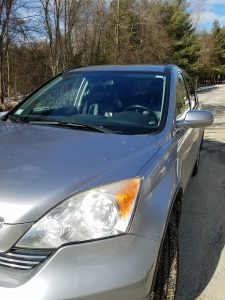A Trust Relationship: It Doesn’t Have to Be “Exhaust”ing
I have a 10-year-old car. It’s a great car – a silver Honda CRV with over 125,000 miles that’s whisked our family on many vacations, transported the kids to and from school, and conveyed me to many a work meeting. I take good care of my car, having it serviced (at the dealer!) whenever it prompts me for service. Then one day, a low rumble from the car’s exhaust startled me.
My dealer told me it would be well over $1000 to replace the muffler and pipe. Again, I love my car. But I couldn’t see spending that amount on it. So, I went to Lou, an exhaust specialist. Lou looked around and identified the problem – a hole in the exhaust pipe. He could repair the pipe for $80. Lou advised me NOT to replace the rest of the still-excellent pipe, and told me the muffler was fine. It would take 20 minutes to fix.

Wow. I probably would have been willing to pay $500, and would have been happy to have saved at least that much. Now I’m sharing the name of the exhaust specialist with my friends and family. What did Lou do that was so great (besides the obvious huge dollar savings)?
I could pretty clearly see a process Lou followed, one I’ve been spending some time with recently. It’s called the Trust Process, from The Trusted Advisor by David Maister, Charles Green, and Robert Galford. Here are the key steps in the trust process, and how I saw them played out:
- Engage – Lou was highly recommended and rated, so I felt he would be a good person to have take a look at my car. Once I met Lou, he helped me feel confident by letting me know he would figure out what the problem was.
- Listen – After listening to my car complaint, Lou put my car on the lift and took a look while I checked my email in the waiting area.
- Frame the Issue – Then he brought me under my car (cool!) and showed my exactly what was going on. I saw the hole, understood how he could repair it, and agreed to the $80 fix. He also told me what I didn’t need to do (replace the whole pipe or the muffler).
- Envision an Outcome – Lou said yes, that this fix would eliminate the noise, and that there would be no adverse impact.
- Commit – I agreed to the work. And, 20 minutes later it was done. My car sounds less “exhaust”ed now.
While this scenario is a bit simplistic, we can probably all apply it to many work situations we encounter. Here is one example from EnVision’s work:
- Engage – In a regular conversation with Barry, a client, about an ongoing project, I realized he might have a need for mentoring, a service we offer. Since we have a strong relationship, I was able to probe and ask more about the situation. This conversation got him engaged and interested in discussing this further.
- Listen – I listened to Barry’s situation, concerns, and needs, asking additional questions to gather more information. This helped him feel he was being heard, and allowed him to clarify his situation.
- Frame the Issue – I recapped what I was hearing about the cause of the challenge Barry shared and explained our mentoring process, asking if that seemed like a useful and appropriate solution, and what concerns Barry had about it. I shared a couple of cases where mentoring has helped other clients in similar situations. This helped Barry to know that I really could help him.
- Envision an Outcome – I continued with the cases, explaining how they turned out and followed with what the outcome could be for Barry’s situation. Now, Barry could see a possible outcome that would be beneficial to him. I suggested we try out mentoring on a small scale, as part of the work we were already doing.
- Commit – Barry agreed to have us provide the limited mentoring services to get his team through immediate deliverables.
Building trust, and a reputation as a trusted advisor, is a key to long-term, productive relationships. What are some ways you already use these steps to build trust with your key stakeholders and partners? What is one step in the trust process you plan to work on enhancing this month?


